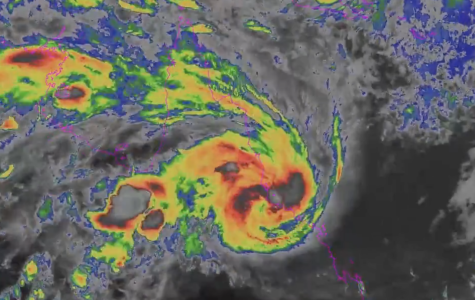Cyclone Kirrily leaves thousands of homes powerless as it crosses the Australian coast
By
Seia Ibanez
- Replies 17
The tranquillity of the Australian coast was shattered as the monstrous Tropical Cyclone Kirrily made landfall on Thursday night, leaving tens of thousands of homes without power and sparking new warnings of flash flooding for central and western Queensland.
The cyclone, one of the most powerful systems seen in the north, has caused significant damage and disruption to the lives of many.
Cyclone Kirrily, which approached the coast as a severe Category 3 system, produced wind gusts up to 170km/h, making it a formidable force of nature.
Cyclone Kirrily’s intensity lowered to Category 2 before making landfall yesterday at 10 pm and eased to a Category 1 system after moving inland, with maximum gusts of 120km/h on Friday midnight.
As it moved inland, it was downgraded to a tropical low as it crossed the coast across northwest of Townsville, but not before it had wreaked havoc.
Senior Meteorologist Miriam Bradbury had said: 'It will carry a lot of that moisture with it, gradually pushing it through central and then more western parts of Queensland.'
'It was more of a wind event than a rain event,' Bradbury shared this morning.
'The rainfall totals only reached 50 to 70mm but plenty of wind damage, with many trees down and debris on the roads and that sort of thing.'
North Queensland had already taken precautions and hunkered down by 2 pm AEST last Thursday as winds intensified.
Offshore coral formations experienced maximum gusts reaching 140km/h, accompanied by continuous winds exceeding 116km/h.
In closer proximity to the coast, the highest gusts were recorded at 107km/h near Alva Beach and approximately 91km/h in the Townsville area.
At around 4 am today, Kirrily was positioned approximately 170km west-southwest of Townsville and 125km west-northwest of Charters Towers. It was moving in a southwest direction at a speed of 24km/h.
The cyclone's impact was felt most acutely in Townsville, where more than 40,000 homes were left without power.
The city's electricity supplier, Ergon, has already started assessing the damage this Friday morning, underscoring the severity of the situation.
In addition to the power outages, the cyclone also caused significant damage to infrastructure.
Boats were reported to have broken loose from their moorings and become stranded along the waterfront in Townsville.
The cyclone also led to the closure of Townsville airport and more than 120 schools, with hundreds of emergency services on standby.
Many Australia Day events set for Friday were cancelled, and train services north of Rockhampton in Queensland were stopped.
You may watch the situation of Townsville below:
Credit: @OreboundImages / X
The Bureau of Meteorology (BOM) issued a severe weather warning for communities in the system's path, forecasting intense rainfall, which could lead to 'life-threatening' flash flooding in some areas.
BOM reported that heavy rain, which could result in flash flooding, is happening in the northern areas of the Northern Goldfields and Upper Flinders, North Tropical Coast, and Herbert and Lower Burdekin districts.
The heavy rain was forecast to extend further inland towards Richmond today and into the northern parts of the Central West district this Friday evening or early Saturday morning.
Expect rainfall totals ranging from 80 to 120mm over a six-hour period, with 24-hour totals potentially reaching up to 180mm, especially on the northern side of the tropical low.
There is also a risk of locally intense rainfall that could result in dangerous and life-threatening flash flooding in the same area.

 Have you been affected by Cyclone Kirrily? Share your experiences and advice for others in the comments below.
Have you been affected by Cyclone Kirrily? Share your experiences and advice for others in the comments below.
The cyclone, one of the most powerful systems seen in the north, has caused significant damage and disruption to the lives of many.
Cyclone Kirrily, which approached the coast as a severe Category 3 system, produced wind gusts up to 170km/h, making it a formidable force of nature.
Cyclone Kirrily’s intensity lowered to Category 2 before making landfall yesterday at 10 pm and eased to a Category 1 system after moving inland, with maximum gusts of 120km/h on Friday midnight.
As it moved inland, it was downgraded to a tropical low as it crossed the coast across northwest of Townsville, but not before it had wreaked havoc.
Senior Meteorologist Miriam Bradbury had said: 'It will carry a lot of that moisture with it, gradually pushing it through central and then more western parts of Queensland.'
'It was more of a wind event than a rain event,' Bradbury shared this morning.
'The rainfall totals only reached 50 to 70mm but plenty of wind damage, with many trees down and debris on the roads and that sort of thing.'
North Queensland had already taken precautions and hunkered down by 2 pm AEST last Thursday as winds intensified.
Offshore coral formations experienced maximum gusts reaching 140km/h, accompanied by continuous winds exceeding 116km/h.
In closer proximity to the coast, the highest gusts were recorded at 107km/h near Alva Beach and approximately 91km/h in the Townsville area.
At around 4 am today, Kirrily was positioned approximately 170km west-southwest of Townsville and 125km west-northwest of Charters Towers. It was moving in a southwest direction at a speed of 24km/h.
The cyclone's impact was felt most acutely in Townsville, where more than 40,000 homes were left without power.
The city's electricity supplier, Ergon, has already started assessing the damage this Friday morning, underscoring the severity of the situation.
In addition to the power outages, the cyclone also caused significant damage to infrastructure.
Boats were reported to have broken loose from their moorings and become stranded along the waterfront in Townsville.
The cyclone also led to the closure of Townsville airport and more than 120 schools, with hundreds of emergency services on standby.
Many Australia Day events set for Friday were cancelled, and train services north of Rockhampton in Queensland were stopped.
You may watch the situation of Townsville below:
Credit: @OreboundImages / X
The Bureau of Meteorology (BOM) issued a severe weather warning for communities in the system's path, forecasting intense rainfall, which could lead to 'life-threatening' flash flooding in some areas.
BOM reported that heavy rain, which could result in flash flooding, is happening in the northern areas of the Northern Goldfields and Upper Flinders, North Tropical Coast, and Herbert and Lower Burdekin districts.
The heavy rain was forecast to extend further inland towards Richmond today and into the northern parts of the Central West district this Friday evening or early Saturday morning.
Expect rainfall totals ranging from 80 to 120mm over a six-hour period, with 24-hour totals potentially reaching up to 180mm, especially on the northern side of the tropical low.
There is also a risk of locally intense rainfall that could result in dangerous and life-threatening flash flooding in the same area.
Tip
Dial Triple Zero (000) for emergencies requiring Police, Fire, or Ambulance assistance. For help with a damaged roof, rising floodwater, fallen trees on buildings, or storm damage, dial SES at 132 500 or use the SES app.
Key Takeaways
- Tropical Cyclone Kirrily struck the Queensland coast and was downgraded to a tropical low after moving inland, causing extensive damage and power outages.
- Despite being downgraded, it continued to pose threats of strong winds and heavy rain, leading to flash flooding warnings for central and western Queensland.
- Over 40,000 homes were left without electricity, with significant damage reported in Townsville and the surrounding areas due to wind and falling trees.
- Emergency services were on standby, with schools and airports closed and severe weather warnings issued for intense rainfall and potential 'life-threatening' flash flooding.








